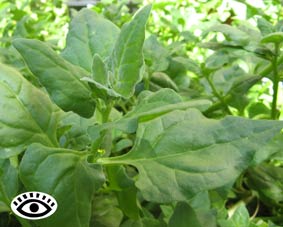Vegetable Varieties
New
Zealand Spinach
Perennial plant with leaves
similar to traditional spinach. Once established this
hardy plant has few pests that attack it, is very low
maintenance and thrives in semi shaded conditions.
description
New Zealand spinach has arrow head shaped mid green leaves of around
4 to 6 cm (1 1/2 to 2 1/2 ")
diameter at their base. It's leaves have a slight furriness to them
and grow out from central stems. The plant produces tiny yellow flowers and quite large seeds of about 1 cm (1/3 ") across. The seeds are very hard when fully mature. It spreads by extending long stems along the ground as well as self seeding.
New Zealand spinach actually makes quite a good ground cover that is pleasant to look at as well a providing a source of food.
Cultivation
Here in Ballarat's
climate it seems to do better in semi shade. My main
patch faces East with an olive tree shading much of the North sun, so it
only gets some full sunlight in the morning and none in the afternoon.
It seems to handle a variety of soil types and can withstand drier conditions,
though it wilts if the soil is completely dry. Doesn't like hot
dry winds.The hardest part is getting it started as the seeds are a little more difficult to germinate because they have a very hard outer pod. To help soften these outer pods soak the seeds in a glass of water the day before you plant them. I planted mine around 2 1/2 cm (1 ") deep in groups of around three or four seeds 30 cm (12") apart. If more than one seed sprouts then thin to the strongest seed. Plant into a soft friable soil. Adding some compost and finely powdered cow manure will help stimulate plant growth.
While it is difficult to get planted seeds to germinate it fairly readily self seeds, so once you have established plants you usually won't need to plant again.
New Zealand spinach is vulnerable to snail and slug attacks when first sprouting but once established little bothers it. Unlike silverbeet, sparrows ignore it, which means doesn't have to be netted.
As it is perennial and continues to grow in cool weather it can be harvested for much of the year. I originally grew it as a backup crop to spinach and silverbeet but it has become a mainstay crop. It's only drawback is that, as the leaves are smaller than spinach or silverbeet, it takes a little bit longer to harvest.
culinary uses
Pick the leaves as a substitute for silverbeet and traditional spinach.
We often use it in quiches and savoury crepes or as a side dish in
itself. It is also good in stir fries, in which you can also use
the upper parts of the stems.

